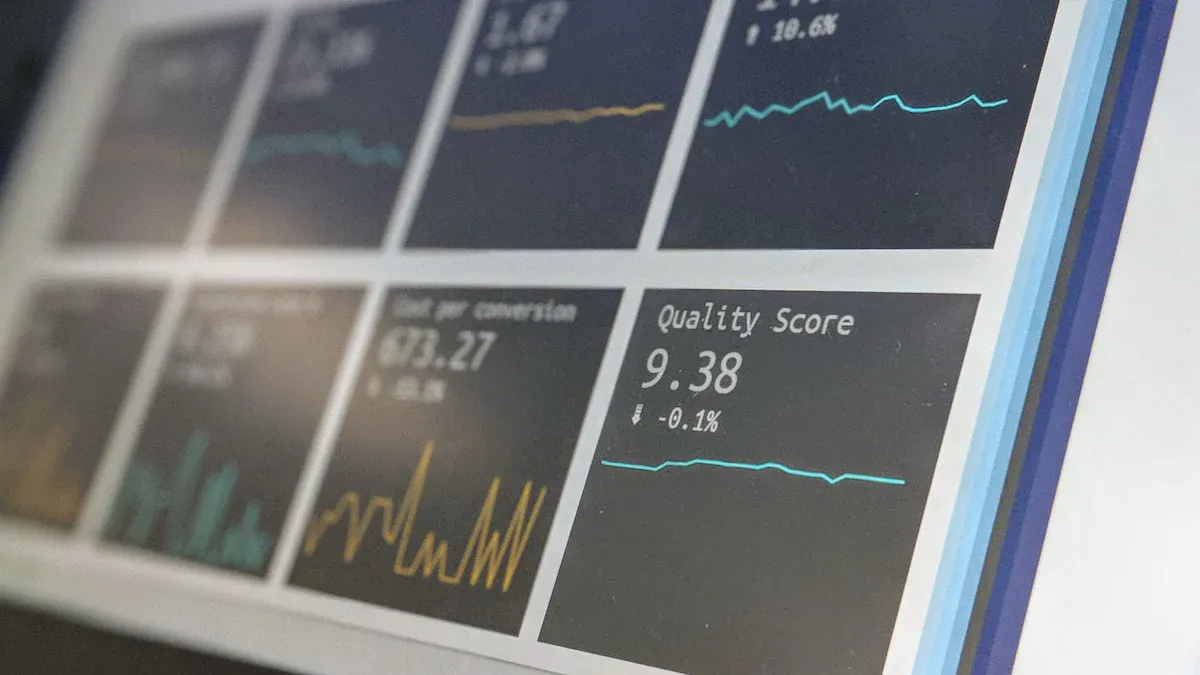How to Select a GDPR-Compliant ATS in Asia

Data protection plays a crucial role in today's hiring processes. If your company in Asia handles EU candidate data, it is essential to comply with GDPR regulations. These rules safeguard personal data and ensure fairness in hiring. Using a GDPR compliant ATS Asia can help you manage data securely while avoiding legal risks. Additionally, the right ATS streamlines and accelerates the hiring process. This guide will assist you in selecting a GDPR compliant ATS Asia that meets your needs.
Understanding GDPR Compliance for Applicant Tracking Systems
Key GDPR principles for ATS
When picking an applicant tracking system, knowing GDPR rules is important. These rules make sure personal data is used safely and fairly. For example:
GDPR Principle | Description |
|---|---|
Lawfulness, fairness, and transparency | Data must be used legally, fairly, and clearly. |
Purpose limitation | Collect data only for clear and valid reasons. |
Data minimization | Gather only the data needed for hiring. |
Data accuracy | Keep candidate data correct and update it often. |
Limitation of storage period | Store data only as long as it’s needed. |
Integrity and confidentiality | Use strong security to protect personal data. |
Proactive responsibility | Pick ATS providers that focus on GDPR compliance. |
Also, GDPR gives candidates rights like seeing, moving, or deleting their data. These rights help candidates and make hiring smoother.
GDPR’s impact on businesses in Asia
GDPR affects companies everywhere, even in Asia. If your company uses EU candidate data, you must follow GDPR rules. This applies no matter where your business is located. Breaking these rules can lead to big fines and hurt your reputation. Using a GDPR-compliant ATS helps you meet global standards. It lowers legal risks and builds trust with candidates and clients.
Why GDPR compliance matters for recruitment
Following GDPR isn’t just about laws; it’s also smart for business. A GDPR-compliant ATS handles consent, lowers risks, and saves time. It keeps you compliant with tools for workflows and reports. These tools improve data quality and make hiring easier. Plus, handling data well makes candidates happier and your system more effective.
Tip: Picking a GDPR-compliant ATS protects your company’s image and helps you grow without extra compliance work.
Features of a GDPR-Compliant Applicant Tracking System

Data encryption and security
A GDPR-compliant ATS must focus on keeping data safe. Encryption makes sure candidate data stays unreadable to hackers. It protects personal details like resumes and contact information. This safety measure works during both sending and storing data. Updating encryption keys often makes it harder for hackers to break in.
Encrypted storage also prevents problems from mistakes or theft. For example, if a device with candidate data is lost, encryption keeps it safe. Changing encryption keys regularly adds extra protection. Even if one key is stolen, the system stays secure. These steps help ATS tools follow GDPR rules and build trust with users.
Tip: A secure ATS avoids legal trouble and improves HR work.
Consent management tools
Consent tools are key for a GDPR-compliant ATS. These tools help collect and track candidate permissions easily. GDPR says you must get clear approval before using personal data. A good ATS makes this simple with forms and tracking features.
For instance, when someone applies for a job, the system asks them to agree to terms. The ATS saves this consent safely to meet GDPR rules. If a candidate changes their mind, the system stops using their data. This not only follows the law but also shows respect for candidates’ choices.
Note: Consent tools show you care about fair hiring practices.
Data minimization and retention
Collecting only needed data is vital for GDPR compliance. A GDPR-compliant ATS gathers just enough information for hiring. For example, it avoids asking for unnecessary personal details. This reduces risks of data leaks and keeps information secure.
Keeping data for too long is also against GDPR rules. An ATS can delete old data automatically when it’s no longer needed. For instance, after hiring ends, the system removes unneeded candidate data. This saves storage space, lowers risks, and follows GDPR standards.
Alert: Breaking data rules has caused fines over 33 million euros. Pick an ATS with strong data tools to avoid these issues.
Audit trails and reporting
Audit trails and reporting are key parts of a GDPR-compliant ATS. These features keep track of how your company uses candidate data. They show every step, from collecting to deleting data, ensuring clear and fair practices.
An audit trail logs all actions related to data. It notes who accessed the data, what was changed, and when it happened. This helps prove your company follows GDPR rules for handling data. For example, if a candidate asks to delete their data, the audit trail shows the request was completed quickly.
Why it matters: Audit trails do more than meet rules. They protect your company by providing proof during disputes or checks.
Reporting tools work with audit trails to improve data management. They create summaries and show how well your processes work. Reports can spot problems like unusual data access or slow responses to requests. Fixing these issues early prevents fines and boosts data safety.
Here’s how audit trails and reporting help with GDPR:
Prove compliance: They show a record of data handling steps and security measures.
Respond to breaches: They track data use and access, helping you act fast during breaches.
Handle requests efficiently: They ensure you meet GDPR deadlines for data access or deletion requests.
Tip: Pick an ATS with strong audit trail and reporting tools. These features make compliance easier and show candidates you care about protecting their data.
Using these tools ensures your ATS meets GDPR rules while keeping hiring safe and smooth.
Evaluating GDPR-Compliant ATS Options
Picking the right ATS needs careful thought. A GDPR-compliant ATS keeps data safe and makes HR work better. It also builds trust with candidates. Here’s how to choose wisely.
Checking certifications and compliance
Certifications show an ATS provider cares about data safety. Look for well-known certifications that prove the system protects sensitive data. These certifications mean the ATS follows strict rules for security and operations.
Certification Type | Description | Link |
|---|---|---|
Recruitee’s ISO 27001 proves secure development and operation of their ATS. | ||
SOC 2 | Recruitee’s SOC 2 report gives extra proof of compliance. | Available on request |
Choose systems with these certifications first. They show the ATS meets global security standards.
Tip: Always check certifications are valid. Ask vendors for proof of compliance.
Reviewing vendor policies
Vendor policies are key for GDPR compliance. Reading these policies shows how the ATS handles data, consent, and rules. Look for policies that clearly explain GDPR and other standards.
Regulation/Standard | Description |
|---|---|
Main rule for data safety in the EU. | |
California Consumer Privacy Act | Law giving privacy rights to California residents. |
Health Insurance Portability and Accountability Act | U.S. law protecting patient medical records. |
ISO/IEC 27001:2022 | Global standard for managing information security. |
Good policies explain how the ATS limits data collection, stores it safely, and deletes it after hiring. They should also show how the system supports candidate rights like data access or deletion.
Why it matters: Clear policies ensure compliance and show candidates you care about fair hiring.
Conducting vendor audits
Vendor audits check if an ATS follows GDPR rules. Audits find weak spots, check data safety, and confirm compliance. A good audit looks at these areas:
Aspect | Description |
|---|---|
Data Security | Checks if the system follows GDPR and protects candidate data. |
Security Measures | Vendors should use encryption, access controls, and regular checks to keep data safe. |
Compliance Assessment | Audits review GDPR compliance and find risks in data handling. |
To do an audit:
Write down any problems found during the check.
See if the vendor meets security rules.
Spot risks and suggest fixes.
Note: Regular audits help the ATS stay updated with new rules and hiring needs.
By checking certifications, reading policies, and doing audits, you can pick a GDPR-compliant ATS. This ensures safe hiring and protects candidate data.
Assessing scalability and integration
When picking an applicant tracking system, think about growth and connections. A system that grows with your company and works well with other tools saves time, reduces mistakes, and boosts efficiency.
Why scalability matters
Scalability means the ATS can handle more work as your company grows. Whether hiring for a small team or many locations, the system should adjust without slowing down. For example, as hiring increases, the ATS must manage more candidate data smoothly. A scalable system avoids delays and keeps hiring on track.
Scalability improves hiring speed and efficiency. A strong ATS shortens the time to hire, even during busy periods. This ensures your hiring process stays fast, no matter how many jobs are open.
Tip: Pick an ATS with flexible pricing or add-on features. This lets you adjust the system to fit your needs.
The importance of integration
Integration shows how well the ATS works with other HR tools. A system that connects with payroll, onboarding, and communication tools makes work easier. It saves time and reduces errors from manual data entry.
Good integration also helps with data analysis. For example, an ATS linked to analytics tools can show which hiring sources work best. It can also track diversity metrics. These insights help improve your hiring strategies.
Here are three ways to check integration:
Hiring Speed: See how quickly the ATS moves candidates through the process.
Data Analysis: Check if the system gives useful reports on hiring data.
Tool Compatibility: Make sure the ATS works well with other HR tools.
Note: Integration isn’t just about working together. It’s about creating a system that improves efficiency and supports hiring goals.
Finding the right fit in the ATS market
There are many ATS options, but not all are great at scaling and connecting. Look for systems that focus on these features and offer customization. A system that fits your business and tools will work best.
When comparing systems, ask vendors about their integration features. Watch demos to see how the ATS works with other tools. This helps you spot problems and pick the right system.
Pro Tip: Choose an ATS with open APIs. This lets you connect it to different tools, making it flexible and ready for the future.
By focusing on growth and connections, you can find an ATS that fits now and later. This makes hiring easier and HR work smoother.
Regional Privacy Considerations in Asia

Key privacy laws in Asia
Asia has many privacy laws, each shaped by local needs. Some countries have made rules similar to GDPR to protect personal data. For example:
Evidence Description | Impact on Privacy Laws |
|---|---|
Inspired nations to create Personal Data Protection laws like GDPR. | |
Disparities in privacy policies | Showed differences in laws, highlighting the need for common rules. |
China's dual approach | Proved even strict states like China can adopt GDPR-like protections. |
China’s Personal Information Protection Law (PIPL) is a key example. It mixes strict surveillance with GDPR-style data protection. This shows strong privacy laws can work with other systems. Similarly, India and Singapore have laws to control data use and protect privacy.
Tip: Knowing these laws helps you handle compliance when picking an ATS.
Intersection of GDPR and Asian regulations
GDPR has shaped many Asian privacy laws, but differences exist. Comparing GDPR with Singapore’s Personal Data Protection Act (PDPA) and Japan’s Act on the Protection of Personal Information (APPI) shows these gaps:
Aspect | GDPR | Singapore PDPA | Japan APPI |
|---|---|---|---|
Objective | Rights-based legislation | Regulates collection, use, and disclosure | Sets rules for handling personal information |
Data Subject Rights | Full rights like data erasure | Basic rights, no right to erasure | No right to data portability |
Compliance Requirements | Detailed records needed | Fewer record-keeping rules | No split between data controllers and processors |
Enforcement Mechanisms | Big fines for breaking rules | Smaller fines, possible jail time | Maximum fine of JPY 1 million (about €6,000) |
Extraterritorial Reach | Applies globally to EU residents' data | Mostly local | Mostly local |
These differences change how you apply GDPR rules in Asia. For example, GDPR’s global reach may need stricter compliance than local laws.
Implications for ATS selection
When picking an ATS in Asia, think about both GDPR and local laws. A good system should meet GDPR rules and adjust to regional needs. For instance, it must handle GDPR data rights while following simpler PDPA record rules.
Scalability is also important. As laws change, your ATS should update without causing problems. Choose systems with flexible features and strong data tools. This keeps hiring smooth and legal.
Pro Tip: Pick an ATS that handles multiple laws to simplify global hiring.
Best Practices for Using a GDPR-Compliant ATS
Top Pick: MokaHR
MokaHR is a great choice for GDPR-compliant ATS needs. It makes hiring easier while keeping data safe. For example, its consent tools help track candidate permissions clearly. The system also hides personal details using data anonymization. This lets you study trends without risking privacy. Audit trails record every time data is accessed. This ensures transparency and helps spot any misuse. Compliance reports show how well you follow privacy laws and fix any issues.
Choosing MokaHR gives you a tool that balances efficiency and safety. It protects candidate data while improving your hiring process. This makes it a dependable option in the ATS market.
Training Staff on GDPR and ATS
Teaching your team is key to using a GDPR-compliant ATS well. Trained staff can spot risks and prevent data leaks. Training also helps follow laws, avoiding fines or penalties. For instance, learning about GDPR rules shows employees how to handle data safely and respect consent.
Training builds a strong security culture. Employees become more careful with sensitive data, boosting your company’s image. Lessons should include data safety, ATS tools, and legal rules for using personal data. This approach earns trust from candidates and improves hiring.
Benefit | Explanation |
|---|---|
Lower Risks | Trained staff can find and fix risks, stopping data leaks. |
Legal Safety | Training ensures you follow GDPR, avoiding fines or penalties. |
Better Reputation | Showing care for data safety builds trust with others. |
Strong Security Culture | Training creates a team that values and protects data safety. |
Regular Checks and Updates
Frequent checks are vital for staying GDPR-compliant in hiring. These checks find weak spots in your data practices and ensure your ATS meets standards. For example, audits help review stored data and confirm it follows GDPR rules. Automated tools can create reports, track data use, and highlight areas to improve.
To make audits better, set clear goals and track progress. Compare results to industry standards and update policies as needed. Use findings to improve training and fix gaps. Automated tools simplify compliance and keep your ATS effective.
Tip: Stay ahead by watching for new rules and testing updates. This keeps your ATS ready for changes and improves your hiring process.
Setting Clear Data Rules
Clear data rules are key to following GDPR. They help your team handle candidate data safely and keep your ATS within the law. Without clear rules, you could face data problems, leaks, or big fines.
Steps to Make Good Data Rules
Decide What Data to Collect
Choose only the data you need for hiring. For example, collect resumes and contact details. Don’t ask for extra personal info like marital status or unrelated health details.Set Time Limits for Data
Decide how long to keep candidate data. GDPR says you must delete data when it’s no longer needed. Use your ATS to erase data automatically, like six months after hiring ends.Control Who Sees Data
Limit access to candidate data based on job roles. For example, recruiters may need full access, but hiring managers might need less. This helps stop data from being seen by the wrong people.Explain Candidate Rights
Add steps for handling requests like fixing or deleting data. Your ATS should help with tools like consent tracking and quick replies.
Tip: Check and update your rules often to match new GDPR or local laws.
Why Clear Rules Are Important
Clear rules build trust with candidates. They show you care about privacy and data safety. They also make audits easier by showing how you handle data. Strong rules protect your company and make you look like a responsible employer.
Picking a GDPR-compliant ATS in Asia is important. It keeps candidate data safe and makes hiring easier. The system should focus on security, consent tools, and following laws. Features like tracking changes, protecting data, and growing with your needs help. These tools make hiring faster and safer. Choosing the right ATS lowers risks and earns trust from candidates. A good system improves hiring and boosts your company’s image in the job market.
FAQ
1. What is GDPR, and why is it important for ATS in Asia?
GDPR is a law from the EU about data safety. It makes sure personal data is used fairly and securely. If you hire people from the EU, you must follow GDPR. This avoids fines and keeps your company’s reputation safe.
2. How do I check if an ATS follows GDPR rules?
Look for certifications like ISO 27001 or SOC 2. Read the vendor’s policies and do audits to check compliance. Ask for proof that the ATS meets GDPR standards.
3. Does GDPR affect companies outside the EU?
Yes, GDPR applies to any company using EU residents’ data. If your business in Asia handles EU candidate data, you must follow GDPR rules.
4. What features are most important in a GDPR-compliant ATS?
Choose tools for managing consent, encrypting data, tracking changes, and deleting old data. These features help follow GDPR and make hiring easier.
5. Can a GDPR-compliant ATS work with privacy laws in Asia?
Yes, many ATS tools can adjust to both GDPR and local laws. For example, they can follow Singapore’s PDPA or Japan’s APPI. Pick one that works with different laws.
See Also
Unlocking ATS Secrets to Discover Exceptional Candidates
Strategies for Spotting Prime Candidates with ATS Tools
Using ATS for Global Recruitment Across Time Zones
Regional Recruitment Strategies: Harnessing ATS Effectively
A Comprehensive Guide to Utilizing Applicant Tracking Systems
From recruiting candidates to onboarding new team members, MokaHR gives your company everything you need to be great at hiring.
Subscribe for more information

